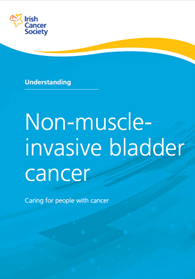Treatment for non-muscle invasive bladder cancer
Most people with non-muscle-invasive bladder cancer will have a surgical procedure called TURBT to remove the tumours. You may have other treatment, depending on the risk group of your cancer.
TURBT surgery
TURBT is a surgical procedure to remove tumours from the lining of your bladder. It is the main treatment for non-muscle-invasive bladder cancer.
After the procedure, the tumour will be examined in a laboratory. This will give your doctor more information about the cancer, such as its stage and grade.
How is TURBT done?
Feelings about surgery
It is natural to feel very anxious about having surgery. Talk to your doctor or nurse if you are feeling anxious. They will tell you what you can expect
after the operation and help you find ways to cope. Ask them any questions you have about your surgery. If there is anything that you do not understand, ask again. They will be happy to answer your questions
Tests before surgery
You will most likely need some extra tests to make sure you are fit for surgery. These tests may include blood tests and an ECG heart test. Sometimes an ECHO (heart ultrasound) and PFT (lung/breathing) tests will be needed, depending on your age and general health.
Smoking and surgery
If you are a smoker, giving up before your operation will improve the
quality of your breathing and reduce the risk of a chest infection after
surgery.
- You will not be allowed to eat or drink for a few hours before surgery.
- You may get an anti-clotting injection like heparin and elastic stockings may be put on your legs to prevent blood clots.
- You will have a general anaesthetic or an anaesthetic injection into your lower back (spinal anaesthetic) so that you will not feel anything. If you have a spinal anaesthetic, you will be awake during the operation.
- The surgeon will put a tube called a cystoscope into your bladder through your water pipe (urethra).
- Special instruments are put through the cystoscope to cut or burn off the tumour.
- The surgeon may use a mild electrical current to seal the wound and stop any bleeding (cauterisation).
After TURBT surgery
- You will most likely have a thin, flexible tube called a catheter in your bladder for a day or two. It drains your urine into a bag and you can walk around with this.
- Don’t be alarmed if your urine is bloodstained at first – this is normal.
- You will be encouraged to drink plenty of fluids to flush out your bladder
and to reduce the risk of developing a urine infection. - Large bags of fluid may be used to flush blood out of your bladder continuously. This prevents blood clots forming and blocking the tube.
- The tube will be removed once you are drinking normally and your urine looks fairly clear. Removing the tube is not painful but may be a little uncomfortable.
- Once the tube is removed, you can go home. This is usually a couple of days after the surgery.
- It is not unusual to see blood in your urine for some weeks after this operation. It may clear up for a few days and then come back again. This will usually clear up.
- If the bleeding is heavy, you are having difficulty passing urine or you are passing clots, it is important that you tell your doctor or specialist nurse straight away.
- TURBT is generally a safe procedure. But, as with any operation, there are some risks. For example, a urinary infection.
- If you feel cold, shivery, hot or sweaty, feel generally unwell, or your urine is smelly or cloudy, please contact your doctor.
- A perforation (hole in your bladder) is a rare complication. Your doctor will explain the potential complications to you before the procedure.
Will I need other treatments after TURBT?
You may have other treatment after TURBT, depending on the risk group of your cancer.
If all the tumours are removed, you may not need any other treatment, but you will have regular checks of your bladder afterwards. You may have chemotherapy treatment into your bladder afterwards. This is known as intravesical treatment
You will likely have chemotherapy or immunotherapy treatments into your bladder after your TURBT.
You will probably have immunotherapy treatments after your TURBT. Or your doctor may discuss surgery to remove your bladder.
Drug treatment after TURBT (intravesical treatment)
You may have liquid chemotherapy or sometimes an immunotherapy drug put into your bladder. This is done to reduce the risk of the cancer coming back or spreading deeper into the bladder. Treatment given directly into the bladder is called intravesical treatment.
Talk to a Cancer Nurse

Support Line
Our Daffodil Centres


